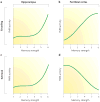Recognition memory and the medial temporal lobe: a new perspective
- PMID: 17948032
- PMCID: PMC2323975
- DOI: 10.1038/nrn2154
Recognition memory and the medial temporal lobe: a new perspective
Abstract
Recognition memory is widely viewed as consisting of two components, recollection and familiarity, which have been proposed to be dependent on the hippocampus and the adjacent perirhinal cortex, respectively. Here, we propose an alternative perspective: we suggest that the methods traditionally used to separate recollection from familiarity instead separate strong memories from weak memories. A review of work with humans, monkeys and rodents finds evidence for familiarity signals (as well as recollection signals) in the hippocampus and recollection signals (as well as familiarity signals) in the perirhinal cortex. We also indicate ways in which the functions of the medial temporal lobe structures are different, and suggest that these structures work together in a cooperative and complementary way.
Figures





Comment in
-
Hippocampal and perirhinal functions in recognition memory.Nat Rev Neurosci. 2008 May;9(5):405; author reply 405. doi: 10.1038/nrn2154-c1. Nat Rev Neurosci. 2008. PMID: 18382467 No abstract available.
Similar articles
-
The medial temporal lobe and recognition memory.Annu Rev Neurosci. 2007;30:123-52. doi: 10.1146/annurev.neuro.30.051606.094328. Annu Rev Neurosci. 2007. PMID: 17417939 Free PMC article. Review.
-
The role of the human hippocampus in familiarity-based and recollection-based recognition memory.Behav Brain Res. 2010 Dec 31;215(2):197-208. doi: 10.1016/j.bbr.2010.04.020. Epub 2010 Apr 20. Behav Brain Res. 2010. PMID: 20412819 Free PMC article. Review.
-
Material Specificity Drives Medial Temporal Lobe Familiarity But Not Hippocampal Recollection.Hippocampus. 2017 Feb;27(2):194-209. doi: 10.1002/hipo.22683. Epub 2016 Dec 26. Hippocampus. 2017. PMID: 27859925 Free PMC article.
-
Measuring recollection and familiarity in the medial temporal lobe.Hippocampus. 2010 Nov;20(11):1195-205. doi: 10.1002/hipo.20854. Hippocampus. 2010. PMID: 20848603 Free PMC article. Review.
-
Thalamic-Medial Temporal Lobe Connectivity Underpins Familiarity Memory.Cereb Cortex. 2020 May 18;30(6):3827-3837. doi: 10.1093/cercor/bhz345. Cereb Cortex. 2020. PMID: 31989161 Free PMC article.
Cited by
-
Using arterial spin labeling perfusion MRI to explore how midazolam produces anterograde amnesia.Neurosci Lett. 2012 Aug 1;522(2):113-7. doi: 10.1016/j.neulet.2012.06.019. Epub 2012 Jun 16. Neurosci Lett. 2012. PMID: 22710004 Free PMC article. Clinical Trial.
-
Overlap between the neural correlates of cued recall and source memory: evidence for a generic recollection network?J Cogn Neurosci. 2012 May;24(5):1127-37. doi: 10.1162/jocn_a_00202. Epub 2012 Jan 30. J Cogn Neurosci. 2012. PMID: 22288393 Free PMC article.
-
Aberrant amplitude of low-frequency fluctuations in different frequency bands and changes after one-night positive airway pressure treatment in severe obstructive sleep apnea.Front Neurol. 2022 Aug 22;13:985321. doi: 10.3389/fneur.2022.985321. eCollection 2022. Front Neurol. 2022. PMID: 36071907 Free PMC article.
-
Emotional learning retroactively promotes memory integration through rapid neural reactivation and reorganization.Elife. 2022 Dec 8;11:e60190. doi: 10.7554/eLife.60190. Elife. 2022. PMID: 36476501 Free PMC article.
-
Cholinergic regulation of object recognition memory.Front Behav Neurosci. 2022 Sep 29;16:996089. doi: 10.3389/fnbeh.2022.996089. eCollection 2022. Front Behav Neurosci. 2022. PMID: 36248033 Free PMC article. Review.
References
-
- Mandler G. Recognizing: the judgment of previous occurrence. Psychol Rev. 1980;87:252–271.
-
- Atkinson RC, Juola JF. In: Contemporary Developments in Mathematical Psychology. Krantz DH, Atkinson RC, Suppes P, editors. Freeman; San Francisco: 1974. pp. 243–290.
-
- Brown MW, Aggleton JP. Recognition memory: what are the roles of the perirhinal cortex and hippocampus? . Nature Rev Neurosci. 2001;2:51–61. - PubMed
-
- Aggleton AP, Brown MW. Interleaving brain systems for episodic and recognition memory. Trends Cogn Sci. 2006;10:455–463. - PubMed
Publication types
MeSH terms
Grants and funding
LinkOut - more resources
Full Text Sources
Other Literature Sources

